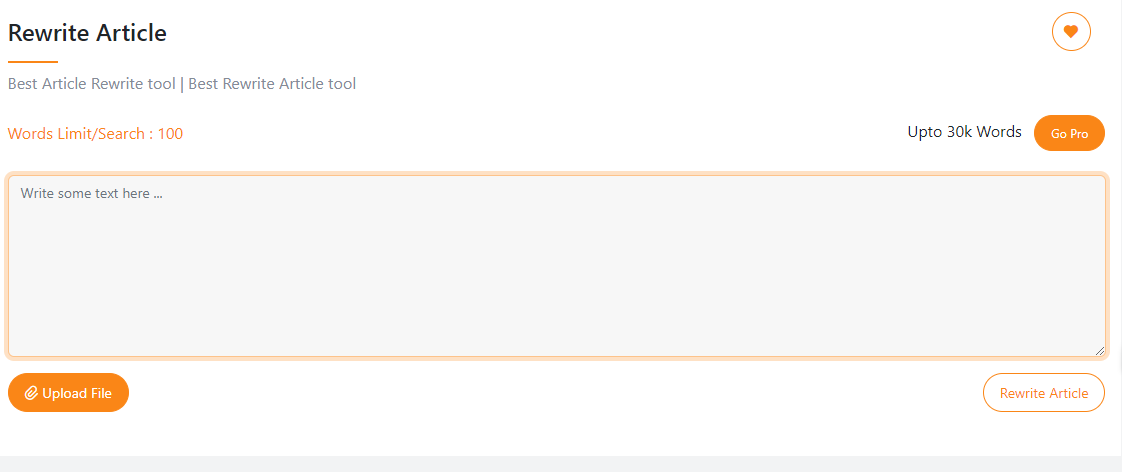
Why You Should Rewrite Your Article and the Best Tool to Use
The invention of numerous writing technologies that aid with the creation of articles or other writing content has various drawbacks, including the potential for violating copyright laws if care is not taken.
With many website users today violation of copyright is always likely to take place with many putting to use these artificial content-creating tools.
Furthermore, many social media users create stuff using artificial intelligence without paraphrasing it, which makes it appear extremely robotic. Anyone familiar with AI's content finds this amusing.
Using artificial intelligence to generate content isn't all that horrible, but when it's written, use an excellent online rewrite tool to polish it.
So how can we improve?
Using the Article Rewrite Tool makes it easier and more realistic to paraphrase your material.
In this guide, we learn how to use an Article Rewrite tool to paraphrase your article to look unique and devoid of copyright and plagiarism
Reasons to Rewrite Your Article

There are several reasons why you might consider rewriting your article. Rewriting an article might seem like a tedious task, but it can significantly enhance its quality and impact.
Here’s why you should consider it and how you can simplify the process:
#1. Improve Clarity and Flow: Writing often begins with a rough draft full of ideas that may be disorganized or convoluted. Rewriting allows you to refine and polish your sentences, ensuring that each one contributes to a cohesive narrative.
You can improve the logical flow of your thoughts and make them easier for readers to understand by reorganizing your writing. This process involves simplifying complex sentences, breaking down lengthy paragraphs, and removing unnecessary jargon.
The result is a polished piece that guides readers seamlessly from one point to the next, improving their overall comprehension and engagement with your content.
#2. Enhance Originality: Even with the best intentions, it’s easy to fall into the trap of unintentional plagiarism, especially when working with common ideas or themes.
Rewriting is an effective strategy for infusing your own voice into your content. It encourages you to reinterpret concepts and express them in a way that is uniquely yours.
When you rephrase and revise sentences, you can prevent plagiarism and introduce a new angle to well-known subjects. The aforementioned method showcases your creative abilities and works to position your voice as an expert in your industry, making your content stand out in a sea of similar material.
#3. Avoid Plagiarism: Plagiarism, whether intentional or accidental, can have serious consequences. Rewriting is a crucial step in avoiding plagiarism by prompting you to generate original content. It pushes you to think critically about the sources you’ve consulted and articulate their ideas in your own words.
This practice reduces the danger of inadvertently duplicating text from other authors and ensures that your work is truely and legally original.
When you generate unique presentations of your thoughts, you maintain academic and professional honesty, which is crucial for preserving credibility and reliability.
#4. Address Copyright Concerns: Copyright infringement can lead to legal troubles and damage your reputation. By rewriting preexisting concepts and material into your own distinctive language, rewriting assists you in avoiding these problems.
When you rewrite content, you are not merely changing words but also rethinking how ideas are presented. This transformation respects the intellectual property of others while ensuring that your work complies with copyright laws.
When you provide fresh perspectives and unique wording, you safeguard yourself from possible disagreements and add to an equitable and courteous creative atmosphere.
#5. Target a Specific Audience: Tailoring content to a specific audience is key to making your message resonate. Rewriting allows you to adjust your language, tone, and examples to better align with the preferences and needs of your target demographic.
For instance, technical jargon might be appropriate for a professional audience but confusing for a general one.
Refining your content can enhance its relevance and attractiveness to your target audience. This strategic approach not only enhances the effectiveness of your communication but also helps build a stronger connection with your audience, increasing their engagement and satisfaction.
#6. Boost SEO: Search engines prioritize fresh, relevant content that provides value to users. Rewriting offers an opportunity to integrate important keywords and phrases that enhance your content’s SEO performance.
You may raise your text's exposure and ranking in search results by adding relevant keywords to it and optimizing it for search engines.
This increased visibility drives more organic traffic to your site and can lead to greater engagement and conversion rates.
Effective SEO rewriting involves balancing keyword integration with maintaining natural, high-quality writing that appeals to both search engines and human readers.
#7. Fix Grammatical Errors: Even with thorough proofreading, some grammatical errors can slip through. Rewriting serves as an additional layer of review, allowing you to identify and correct typos, grammatical mistakes, and awkward phrasing.
This step provides a chance to refine your language and ensure that your writing adheres to proper grammar and usage rules.
Addressing these issues during the rewriting process, you enhance the professionalism and credibility of your content, ensuring that it meets high standards of readability and accuracy.
#8. Enhance Readability: Complex ideas and dense text can be daunting for readers. Rewriting helps to simplify and clarify your content, making it more accessible and engaging.
This involves breaking down long paragraphs into shorter, more manageable sections, using bullet points or subheadings to organize information, and eliminating jargon or overly technical language.
Improving the readability of your content makes it more appealing and easier for your audience to understand, thereby enticing them to remain engaged and grasp your main points.
#9. Refine Your Message: Rewriting provides an opportunity to hone your core message and ensure it is clearly and consistently communicated.
This process involves revisiting your main points, eliminating redundant or irrelevant information, and tightening your arguments.
You ensure that your content remains focused and impactful, effectively conveying your intended purpose to the reader by refining your message.
This clarity not only strengthens the overall quality of your work but also helps to reinforce your central themes and objectives.
Should You Use a Rewriting Tool?
There are two main approaches to rewriting: manual and automated.
#1. Manual Rewriting
This gives you complete control over the final product. You can restructure sentences, add details, and ensure your unique voice shines through. However, it can be time-consuming.
#2. Article Rewriting Tools
These AI-powered tools can paraphrase sentences, suggest synonyms, and offer different writing styles. They're a great time-saver, but be aware that they can produce nonsensical content if not used carefully.
When choosing a rewriting tool, it's important to consider several factors to ensure the tool meets your needs. Here are some things to consider:
#1. Accuracy: The tool should maintain the original meaning of your content while rephrasing it. Accuracy is crucial to ensure that the core message and intent of your text remain intact, even after rewriting.
#2. Readability: The rewritten content should still flow naturally and be easy to understand. A good rewriting tool should produce text that is coherent and engaging, without awkward phrasing or grammatical errors.
#3. Originality: Make sure the tool generates unique content to avoid plagiarism concerns. It's important that the rephrased text is sufficiently different from the original to pass plagiarism checks and maintain the integrity of your work.
Here are some popular article rewriting tools to explore:
#1. Techbiztools
#2. Grammarly
#3. Quillbot
#5. Wordtune
Note, rewriting tools are best used as an assistant, not a replacement for your own writing skills.
How to Rewrite Your Article
After you have created your content, whether through an online platform or manually, you may want to ensure that your grammar is correct and possibly paraphrase it.
Here’s a step-by-step guide on how to do this using the website:

#1. Access the Techbiztools Website: Visit the Techbiztools website. Navigate to the Text Analysis Tools section.
#2. Locate the Article Rewrite Tool: In the Text Analysis Tools section, look for the Article Rewrite tool.
#3. Input Your Content: You can either type your content directly into the provided text box, paste it from your clipboard, or upload a file from your computer or phone.
#4. Rewrite the Article: Click on the Rewrite Article button. The tool will process your content and provide a rewritten version.
#5. Review the Output: Your rewritten article will be ready in a few moments.
#6. Proofread the Result: Remember to proofread the generated content for any mistakes. While the tool is highly useful, it may not be 100% perfect as it is software-based. Checking for errors will ensure the quality of your final article.
Conclusion
By embracing the power of rewriting, you unlock a world of possibilities. You can transform your writing from good to exceptional, captivate your readers, and achieve your content creation goals. So, don't be afraid to hit that backspace button – it could be the key to unlocking your writing's true potential.